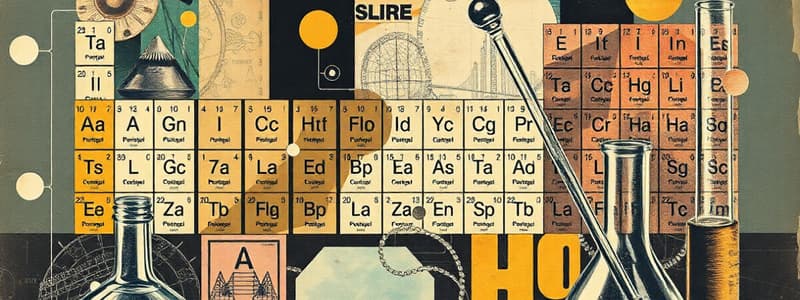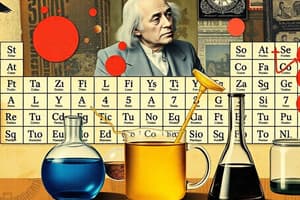Podcast
Questions and Answers
What are the basic units of matter?
What are the basic units of matter?
- Elements
- Ions
- Molecules
- Atoms (correct)
Which type of bond involves the transfer of electrons?
Which type of bond involves the transfer of electrons?
- Ionic Bond (correct)
- Covalent Bond
- Hydrogen Bond
- Metallic Bond
Which reaction type is represented by the equation AB → A + B?
Which reaction type is represented by the equation AB → A + B?
- Combustion
- Single Replacement
- Decomposition (correct)
- Synthesis
What is the pH of a neutral solution?
What is the pH of a neutral solution?
What is released during exothermic reactions?
What is released during exothermic reactions?
In a solution, what is the solvent?
In a solution, what is the solvent?
Which state of matter has a definite shape and volume?
Which state of matter has a definite shape and volume?
What does stoichiometry focus on in a chemical reaction?
What does stoichiometry focus on in a chemical reaction?
Flashcards are hidden until you start studying
Study Notes
Fundamental Concepts of Chemistry
-
Matter: Anything that has mass and occupies space. Exists in solid, liquid, and gas states.
-
Atoms: Basic unit of matter, composed of protons, neutrons, and electrons.
- Protons: Positive charge, located in the nucleus.
- Neutrons: No charge, located in the nucleus.
- Electrons: Negative charge, orbiting the nucleus.
-
Elements: Pure substances made up of only one type of atom; represented by symbols on the periodic table.
The Periodic Table
- Organizes elements by increasing atomic number.
- Groups (columns) indicate elements with similar chemical properties.
- Periods (rows) indicate energy levels of electrons.
Chemical Bonds
- Ionic Bonds: Formed when electrons are transferred from one atom to another, creating charged ions.
- Covalent Bonds: Formed when atoms share electrons.
- Metallic Bonds: Involves a 'sea of electrons' freely moving among metal atoms.
Chemical Reactions
- Reactants: Substances that undergo a change in a reaction.
- Products: Substances formed as a result of a reaction.
- Types of Reactions:
- Synthesis: A + B → AB
- Decomposition: AB → A + B
- Single Replacement: A + BC → AC + B
- Double Replacement: AB + CD → AD + CB
- Combustion: Hydrocarbon + O₂ → CO₂ + H₂O
Acids and Bases
- Acids: Substances that release hydrogen ions (H⁺) in solution (e.g., HCl).
- Bases: Substances that release hydroxide ions (OH⁻) in solution (e.g., NaOH).
- pH Scale: Measures acidity (pH < 7) and alkalinity (pH > 7); neutral at pH 7.
Stoichiometry
- Involves calculations related to the quantities of reactants and products in a chemical reaction.
- Based on the conservation of mass: mass of reactants = mass of products.
Thermochemistry
- Studies the heat changes associated with chemical reactions.
- Exothermic Reactions: Release heat.
- Endothermic Reactions: Absorb heat.
States of Matter
- Solid: Definite shape and volume.
- Liquid: Definite volume, takes the shape of the container.
- Gas: No definite shape or volume, expands to fill the container.
Solutions
- Solvent: Substance that dissolves the solute (e.g., water).
- Solute: Substance that is dissolved (e.g., salt).
- Concentration: Amount of solute in a given volume of solvent.
Key Laboratory Techniques
- Titration: Technique to determine concentration by reacting a solution with a known concentration.
- Filtration: Separating solids from liquids using a filter.
- Distillation: Separating mixtures based on differences in boiling points.
Safety in the Chemistry Lab
- Always wear safety goggles and gloves.
- Know the location of safety equipment (eyewash, fire extinguisher).
- Properly label and store chemicals.
Fundamental Concepts of Chemistry
- Matter has mass and occupies space, existing in solid, liquid, and gas states.
- Atoms are the fundamental units of matter, consisting of protons, neutrons, and electrons.
- Protons possess a positive charge and are found in the nucleus.
- Neutrons carry no charge and reside in the nucleus.
- Electrons are negatively charged particles that orbit around the nucleus.
- Elements are pure substances made of only one type of atom, represented by symbols on the periodic table.
The Periodic Table
- Elements are organized by increasing atomic number.
- Groups (columns) signify elements with similar chemical properties.
- Periods (rows) indicate the number of energy levels occupied by electrons in the atoms.
Chemical Bonds
- Ionic bonds result from the transfer of electrons between atoms, forming charged ions.
- Covalent bonds are created when pairs of electrons are shared between atoms.
- Metallic bonds involve a collective pool of electrons that move freely among metal atoms.
Chemical Reactions
- Reactants are the initial substances that undergo transformation during a reaction.
- Products are the new substances formed as a result of the chemical reaction.
- Types of chemical reactions include:
- Synthesis: Two or more reactants combine to form one product (A + B → AB).
- Decomposition: A single compound breaks down into two or more products (AB → A + B).
- Single Replacement: One element replaces another in a compound (A + BC → AC + B).
- Double Replacement: Exchange of ions between two compounds (AB + CD → AD + CB).
- Combustion: A hydrocarbon reacts with oxygen to produce carbon dioxide and water (Hydrocarbon + O₂ → CO₂ + H₂O).
Acids and Bases
- Acids are substances that release hydrogen ions (H⁺) in solution, like hydrochloric acid (HCl).
- Bases release hydroxide ions (OH⁻) in solution, such as sodium hydroxide (NaOH).
- The pH scale measures acidity (pH < 7) and alkalinity (pH > 7), with neutrality at pH 7.
Stoichiometry
- Stoichiometry involves calculations regarding reactant and product quantities in chemical reactions.
- It is based on the principle of conservation of mass, where the mass of reactants equals the mass of products.
Thermochemistry
- Thermochemistry examines the heat changes that occur during chemical reactions.
- Exothermic reactions release heat, while endothermic reactions absorb heat.
States of Matter
- Solids have a definite shape and volume.
- Liquids have a definite volume but take the shape of their containers.
- Gases have no fixed shape or volume, expanding to fill their containers.
Solutions
- Solvents dissolve solutes; for example, water acts as a solvent for salt.
- Solutes are substances that are dissolved within the solvent.
- Concentration refers to the quantity of solute contained in a specific volume of solvent.
Key Laboratory Techniques
- Titration measures concentration through the reaction of a solution with a known concentration.
- Filtration is used to separate solids from liquids using a filtering medium.
- Distillation separates liquid mixtures based on differences in boiling points.
Safety in the Chemistry Lab
- Safety goggles and gloves should always be worn to protect against hazards.
- Familiarity with the location of safety equipment (eyewash stations, fire extinguishers) is crucial.
- Chemicals must be properly labeled and stored to prevent accidents.
Studying That Suits You
Use AI to generate personalized quizzes and flashcards to suit your learning preferences.




